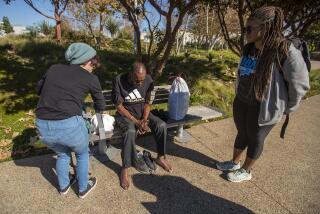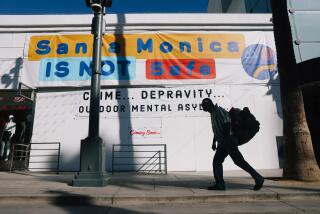Police Move to Bar Homeless From Returning to Riverbed
- Share via
Ventura police posted officers at the banks of the Ventura River on Wednesday to block homeless inhabitants of the riverbed from moving back in, while city officials scrambled to find long-term housing alternatives.
Angered by the cost and risk of rescuing homeless people Tuesday from the flooded river and anxious even before this week’s rains to get them out, Ventura City Council members seized Tuesday’s flood as a chance to finally clear out the riverbed.
“We had to even put our own people’s lives at risk to rescue people who didn’t really give a damn,” Councilman Jack Tingstrom said. “They didn’t want to leave, so the river was rising and they were hung up in the trees.
“Now that they’re out, I want to keep them out.”
To that end, two officers stood guard Wednesday afternoon where Main Street meets the waterway, turning away curiosity seekers and former squatters trying to wriggle under the yellow police tape.
“Certainly it’ll be a big job for a while,” Ventura Police Chief Richard Thomas said. “But we don’t want people down on the river bottom. The mayor has asked the department to enforce ordinances that are on the books, and we are prepared to do that.”
Even so, some homeless managed to sneak back into the riverbed Wednesday. Other transients, learning of the council’s plan as they waited at shelters, derided the city’s ability to keep them away from the riverbed.
“You can arrest me as many times as you want, but you can’t prevent me from going home,” said former river bottom resident Craig Fearnow, 38, residing now at a shelter on Ventura Avenue.
Meanwhile, city officials wondered where they would put the city’s homeless after declaring a zero tolerance policy for river bottom encampments.
For the moment, many former river dwellers moved into an emergency shelter set up by the American Red Cross at De Anza Middle School near Ventura Avenue.
But David Myers, the school’s principal, said his students needed their gymnasium back by Monday. “Obviously, a school cannot be a place where the homeless can be housed until there’s a political solution,” he said.
City Council members for a while tossed about the idea of opening an interim shelter at the Ventura County Fairgrounds--until they learned the fairgrounds had no room.
So, at a loss for other shelter ideas and with the river bottom closed, city officials said they were unsure where homeless people are supposed to spend their nights in the coming weeks.
“I don’t know. Hopefully, someplace that is as safe and healthy as the river bottom,” Mayor Tom Buford said sarcastically.
The city’s decision caps months of debate over what to do with the approximately 200 people who set up shanties along the river bottom, creating makeshift homes along once-pristine land.
Environmentalists have decried the destruction of the area’s natural habitat and the squatters’ dumping of waste and debris down the river itself.
Merchants have complained about what a nuisance and a public spectacle the transients are as they wander around downtown streets.
Caught amid the public distress, council members said even before Tuesday’s flood that they longed to kick the squatters out. But they hesitated to take any action because of legal questions about whether such a move would be a violation of homeless people’s civil rights.
However, with the river accomplishing the removal for them, wiping out nearly all traces of the shanties that only two days ago cluttered its banks, council members said they are now ready to enforce no-camping ordinances already on the books.
“Reality is upon us,” said Councilwoman Rosa Lee Measures. “It’s truly an opportunity, now that they have fully vacated, to really address this health and safety issue.”
Many city residents strolling the downtown streets Wednesday said they support the decision.
“It’s a good idea,” said Phillip Ridgway, 44, walking along Main Street with his wife, Marian, and their dog Liberty. “With the money they spent rescuing all those people, they could have already built a homeless place for them.”
But the city’s plan faced snags even in its infancy.
Ventura police said they are ready to enforce the new policy indefinitely--but council members admitted that the police probably do not have the funds to provide long-term, round-the-clock enforcement.
Homeless advocates, while conceding that the Ventura River bottom is not a safe place to live, questioned the city’s resolve to provide alternative housing.
“If they are going to enforce this, then they need to look seriously and immediately at some other possibilities for these people,” said Mary Ann Decaen, the community services coordinator for Catholic Charities, which provides services to the homeless.
Some service providers speculated that, without the river bottom at their disposal, the city’s homeless might set up camp in far more visible locations on city streets.
“I don’t know that we have a good solution here,” said Clyde Reynolds, director of the Turning Point Foundation, which serves the homeless mentally ill. “We have people here who consider Ventura their home. I’m concerned that this may be more of a reaction than something we have time to carefully plan.”
One of the first steps the city took, Measures said, was to ask shelter supervisors to get the names of every person they admitted for the night, in an attempt to keep some kind of tabs on Ventura’s homeless population.
Eventually, she said, she hopes to see those people moved into local hotels, using city- and county-subsidized vouchers, or into a new shelter partially financed by the city.
Many on the council, however, including Measures, said they had no idea what the tab for such a program would be, or where the city would find the money to pay for it.
Councilman Gary Tuttle, while applauding the river bottom decision, said Ventura could be setting itself up for a public relations debacle.
Tuttle opposed removing the river bottom homeless only two months ago, saying the situation could “get ugly.” Now, however, he said he enthusiastically supports the idea.
“What’s changed is the flood,” he said. “It changed a lot of things. That was a disaster, and we’ve got to turn it into an opportunity.”
More to Read
Sign up for Essential California
The most important California stories and recommendations in your inbox every morning.
You may occasionally receive promotional content from the Los Angeles Times.









